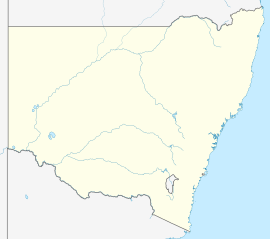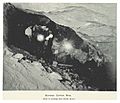Burraga facts for kids
Quick facts for kids BurragaNew South Wales |
|
|---|---|
| Postcode(s) | 2795 |
| LGA(s) | Oberon |
| County | Georgiana |
| Parish | Jeremy, Thompson |
| State electorate(s) | Bathurst |
| Federal Division(s) | Calare |
Burraga is a small town in the Central Tablelands area of New South Wales, Australia. It is about 47 kilometres southwest of Oberon. It is also about 67 kilometres south of Bathurst. Burraga is part of the Oberon Shire. In 2016, 91 people lived in Burraga.
Contents
Discovering Burraga's Past
Early Days and First People
The land where Burraga is today traditionally belongs to the Wiradjuri people. The name "Burraga" likely comes from an Aboriginal word. Some say it means "Bitter Swamp." Burraga is also the name of a local land area (called a cadastral parish). This area is on the north side of Thompson's Creek.
The Story of Copper Mining
Copper was found near Burraga around 1877. Mining started at the Thompsons Creek copper mine. But it faced problems with money and management. In 1879, Lewis Lloyd bought the mine. He was known as "the copper king." The mine then became Lloyd's Copper Mine.
Lloyd built special furnaces (called reverberatory smelting furnaces) to melt the copper ore. By 1900, the mine had produced a lot of copper. It was worth over £1,000,000.
Challenges and Closures
In 1899, Lloyd sold his share of the mine to an English company. The mine was renamed the Lloyd Copper Company Mine. Mining was hard because there wasn't enough water or fuel for the furnaces. The new owners built a concrete dam on Thompson's Creek in 1901. It filled with water by 1903.
They also tried a new way of melting copper. But it didn't work well. By 1908, the mine was in trouble. It closed in May that year. The only mining left was at the nearby Mt David Gold Mine.
The Lloyd mine seemed to open again around 1912. New money was invested. A narrow train track was built to bring wood fuel to the smelter. Two special trains called Shay locomotives were used. One train was destroyed in a fire in 1913.
Copper prices then dropped. This led to another mine closure in July 1914. The whole mine was sold in 1916 for a very low price. The new owners called it the Abercrombie Copper Mine. It started working again in March 1917. But getting enough wood fuel was still a problem.
By mid-1918, it was hard to send copper overseas because of the war. The smelter at Burraga closed in August 1918. The copper ore was sent to Port Kembla instead. It went by train from Perthville.
The mine finally closed in January 1919. Its equipment, including the last Shay locomotive, was sold in 1920. A railway line was planned to reach Burraga. It would have brought coal for the smelters. But it was only built as far as Oberon. This line opened in November 1923.
Mining continued on and off until 1961. Around 2012, people were still looking for copper and gold nearby.
Burraga: A Town's Journey
The first settlement in Burraga was a private town. It was built on the land of the copper mine. As the mine grew, more workers moved there. So, a new village area was set aside in October 1883.
In 1883, about 200 men worked at the mine. The town of Burraga had about 500 people, including 60 children. The village had shops, a post office, and a public school. The school opened in November 1883. This shows that many people lived there even before the village was officially planned.
The new village was mapped out in December 1884. Its official plan was set in October 1887. A road was planned to connect the private town to the new village. But some buildings were already on the road's path. So, the road was re-mapped in 1900.
The mine's land also affected how some streets were built. This is why some of Burraga's buildings are outside the main village area. You can still see parts of the old private town on Google Maps.
Ups and Downs of Population
The town's success depended on the copper mine. When the mine was busy, the town grew. The population reached about 2,000 in the early 1900s. This was when new buildings were being made at the mine.
When the mine closed for the first time in 1908, about 1,500 people still lived there. By 1911, the population dropped to 747. It went up again to about 1,400-1,500 when the mine reopened. But after the second closure in 1914, it fell to only 250 by 1916. After the final mine closure in 1919, the population was 1,231. By 1924, only 124 people lived in the village.
Burraga had two hotels. The Royal Hotel burned down in 1932. The Burraga Hotel closed in 1933. Its empty building also burned down in 1942.
The village had a Union Church, an Anglican church, and a Catholic church. Only St Dympna's Catholic church is still standing. It was built in 1941 and is still used today.
The public school closed in December 2006. It reopened in February 2009. But it closed for good in December 2016.
Between 1900 and 1915, a photographer named Evan Antoni Johann Lumme took pictures of Burraga. Some of his photos are now kept at the National Library of Australia.
Burraga Today
Not much is left of the old copper mine. A tall brick chimney still stands. It is from the failed attempt at a new melting process. The Burraga Dam on Thompson's Creek is still there. It is a popular place for fishing. You can also see old mine shafts and piles of waste rock (slag heaps). The mine site and the village are sometimes considered for filming movies.
Today, Burraga is a quiet village. It still has a community hall and a village store. The store also acts as a post office. Besides some tourism for camping and fishing, the town's economy relies on farming (grazing), nearby tree farms (softwood forestry), and sawmills.
The War Memorial Obelisk in the village park honors the men from Burraga who fought in the two world wars. The Burraga Sports and Services Club serves the village and nearby areas.
Gallery





